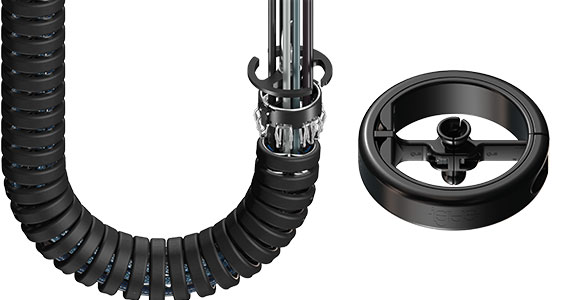ready for smart – does that make sense in offshore applications?
Richard Habering | 19. May 2020
Offshore – where service work costs millions: is that really necessary? Energy supply at drilling rigs, construction machines and shore power applications – cold, wet, dirty and heavy. Real stress for thick cables and hard hoses, but also for sensitive bus and data cables. Too much stress leads to breakages – which usually cost a lot of time and money. €50,000 to €100,000 for a helicopter or ship is quickly used up. Production losses do not go down very well with the management either.
The system lasts longer if the new e-loop is used. Thick polymer modules provide protection and lengthen the time until the next maintenance. In case of an emergency, cables and chain parts can be replaced individually. This results in a significant reduction of unexpected service costs. If, in addition, there was a technology that prevented the package from being damaged during tilting, or that notified users whenever the cable service life reached its end, the service of drilling rigs or large construction or agricultural machines could become a relaxing job.

On the right: an individual e-loop segment
In 2016, we launched the CF.Q system on the market under the name CF.Q “Intelligent Cable”. It monitors the mechanical condition of the cable by means of additional elements and provides information on potential problems in advance. Usually, the additional elements admittedly require a special cable. Since 2018, we therefore determine the condition of Ethernet cables by means of measurements of the used wires in the CF.D concept. In the beginning, an industrial PC was inserted into the cable. This was replaced by smaller units in 2019.
In our laboratory, cables are tested up to “the end of their life”, so that AI or machine-learning elements are not needed to determine their condition. This reduces the required calculation effort and hence allows for more cost-effective technology approaches.
Sea, storm, swaying, ice, snow – all of these things can cause a lot of trouble. If the service loop gets caught in the construction, the high drive forces can destroy the entire system in just a few seconds. This does not have to be the case. With the EC. PR system, we measure the forces at the moving end in relation to the position. As soon as the limits for these forces are exceeded, the equipment is informed in milliseconds and switches itself off.
System stopped quickly, danger averted – clear blockage and carry on.
If the system is connected to an ICOM module, the service technician or other authorised persons are informed via the Intranet or Internet and can clear the blockage remotely in many cases.
Anyone who now feels that they are “ready for smart” should contact an igus® colleague of their choice as quickly as possible and order a test system without delay.

